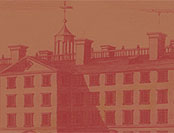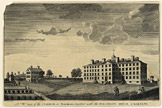


New England
Slavery and the Slave Trade in Rhode Island
The Brown Family
and the Slave Trade:
The Voyage of the Sally
> Brown University
![]()
The brig Sally sailed from Newport, Rhode Island, in 1764, also the year of the founding of the College of Rhode Island in Warren. By 1770, the College of Rhode Island had moved to Providence and in 1804 was renamed Brown University. [16] The College Edifice, today called University Hall (the oldest building on campus), [15] was largely financed by Nicholas Brown & Company, who fought hard for the permanent home of the college to be in Providence. [13 & 14]

![[13 & 14] A Permanent Home for the College](../Images/Thumbnails/Item13_thumb.jpg) ![[13 & 14] A Permanent Home for the College 2](../Images/Thumbnails/Item14_thumb.jpg) |
[13 & 14] A Permanent Home for the College larger view
Nicholas Brown & Co. to Job Bennett. (Providence: December 29, 1769). On Commencement Day, 1769, “the Corporation attempted to settle upon a permanent home for the college.” A tug-of-war between Warren, Newport, East Greenwich, and Providence ensued. Here Nicholas Brown writes to Colonel Job Bennett, a judge of the superior court (and one of the original petitioners for the College), asking for his pledged subscription in support of Providence ($9,000 was eventually raised). Eventually, Nicholas Brown & Co. would be credited with the execution of the planning, fundraising, and building of the “College Edifice” (known since 1823 as University Hall)—begun in 1770, and finished in 1778. |
![[15] Plan of University Hall](../Images/Thumbnails/Item15_thumb.jpg) |
[15] Plan of University Hall larger view
[Preliminary plan of University Hall]. Drawn by Silas Downer (Providence, 1770). In a 1960 draft of his unpublished history of University Hall, Lawrence Wroth says of this item, “It is a fact that despite the existence in good condition of nearly five hundred papers relating to the construction of the College Edifice only one specimen of an architectural drawing concerning the proposed building is known to remain . . . [it was] drawn by Silas Downer, a Providence scrivener, at the request of Chancellor Stephen Hopkins [brother of Esek Hopkins] . . . The Downer drawing is a first floor plan for a building measuring 108 feet long, 44 feet deep, and here is the new and important feature, 64 feet deep at the center . . . Thus was created a central pavillion which broke an otherwise monotonous façade . . . The likeness of this feature of Plan 3 to the overall plan of Princeton’s Nassau Hall may properly suggest that at this stage President Manning had taken things in hand [Manning was a graduate of Princeton, then known as the College of New Jersey]. |
 |
[16] View of the College Edifice larger view
[Providence, 1792]. A S. W. view of the college in Providence, together with the president’s house & gardens. This image of the College Edifice was engraved by David Leonard, who graduated from Brown in 1792. |